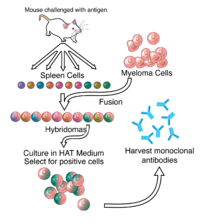
Photo from wikipedia
Objectives: The coronavirus disease 2019 (COVID-19) is still a global health concern caused by the severe acute respiratory syndrome coronavirus 2 (SARS-CoV-2). The functional entry receptor utilized by SARS-CoV-2 is… Click to show full abstract
Objectives: The coronavirus disease 2019 (COVID-19) is still a global health concern caused by the severe acute respiratory syndrome coronavirus 2 (SARS-CoV-2). The functional entry receptor utilized by SARS-CoV-2 is Angiotensin-Converting Enzyme 2 (ACE2). ACE2 is a key modulator of the Renin-Angiotensin System (RAS), which plays an essential role in human physiology. During the early phase of COVID-19, controversies remained regarding whether COVID-19 patients with underlying conditions have aberrant expression of ACE2 and if ACE2 levels correlate with the severity of COVID-19. Currently, limited data provide a relationship between ACE2 expression and COVID-19 pathogenesis and mortality. We hypothesize that a positron emission tomography (PET) radiotracer with high binding affinity and selectivity can be used to determine whole-body ACE2 levels in vivo. Therefore, the study aims to rationally design and synthesize new ACE2 inhibitors targeting ACE2 in animal models. Methods: A series of ACE2 compounds were designed based on a known ACE2 inhibitor MLN-4760 (IC50 = 0.44 nM against soluble human ACE2). The probes and reference compound MLN-4760 were modeled into ACE2 using Schrodinger’s Glide. Following docking, full atom refinement was performed using Prime MM-GBSA for the ligands. Next, the new compounds were synthesized in eight steps through functional group protection, alkylation, deprotection, reductive amination reaction, hydrolysis, and diastereomeric separation to obtain four pairs of diastereoisomers. Results: Eight new ACE2 compounds and four pairs of diastereoisomers with one (or two) fluorine-19 atoms were designed. The lead compound, MLN-4760, makes several interactions with ACE2. Molecular modeling suggested that adding fluorine in the para position is tolerated within the binding site, allowing the probe to bind with essentially the same pose as MLN-4760, regardless of stereochemistry. However, replacing a chlorine with a fluorine had a disruptive effect. All the probes were scored and ranked. ( R, S)-1c is able to bind a pose that is highly overlapping MLN-4760, resulting in a similar docking score to MLN-4760. Furthermore, the eight compounds were synthesized by traditional organic chemistry procedures. The target compounds were characterized by 1H NMR, 13C NMR, 19F NMR, LC-mass, and HPLC with over 95% chemical purity and 95% diastereoselective values. Conclusions: A series of fluorine-19 containing inhibitors targeting ACE2 were designed and synthesized with high chemical purity and diastereoisomeric purity. Molecular modeling suggests that the fluorine-19 substitution will be well tolerated, and these compounds are expected to have similar potency to the lead compound, MLN-470. The binding assay of the newly synthesized compounds for ACE2 and selectivity over ACE1 is ongoing. The work was supported by the NIH R21 grant EB032025 from the National Institute of Biomedical Imaging and Bioengineering (NIBIB); the Nemours Diagnostic & Research PET/MRI Center; the Departments of Radiology and Biomedical Research at Nemours Children's Hospital, Delaware. This is the full abstract presented at the American Physiology Summit 2023 meeting and is only available in HTML format. There are no additional versions or additional content available for this abstract. Physiology was not involved in the peer review process.
Journal Title: Physiology
Year Published: 2023
Link to full text (if available)
Share on Social Media: Sign Up to like & get
recommendations!